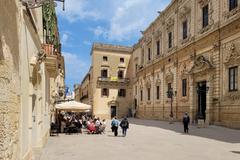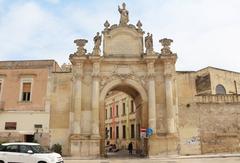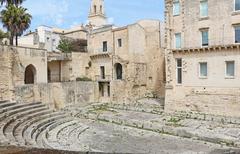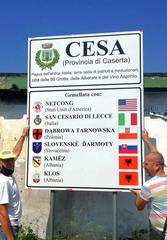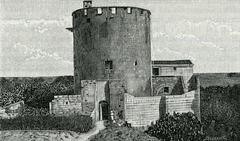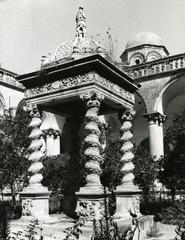Visiting the Gate of Saint Blaise in Lecce: Hours, Tickets, and History
Date: 18/07/2024
Introduction
Nestled in the heart of Lecce, Italy, the Gate of Saint Blaise, or Porta San Biagio, stands as a remarkable testament to the city’s rich history and architectural prowess. This Baroque masterpiece, constructed in 1736, replaces an older gate dating back to the 15th century, embodying the city’s evolution and resilience. The gate’s name honors Saint Blaise, the patron saint of Lecce, who, according to legend, saved the city from a devastating plague in 1656 (source). The Gate of Saint Blaise is a symbol of Lecce’s grandeur, reflecting the city’s embrace of the Baroque style and its historical significance under Spanish dominion. This comprehensive guide will delve into the historical background, architectural features, visitor information, and travel tips, ensuring a rich and informative experience for anyone looking to explore this iconic monument.
Table of Contents
- Introduction
- Historical Background
- Visitor Information
- Travel Tips
- Nearby Attractions
- Accessibility
- Special Events and Guided Tours
- Photographic Spots
- FAQ
- Conclusion
Historical Background
The Patron Saint and the Plague
The gate’s name honors Saint Blaise, the patron saint of Lecce. Legend has it that Saint Blaise miraculously saved the city from a devastating plague in 1656. As a gesture of gratitude, the citizens of Lecce dedicated the gate to their protector, solidifying his place in the city’s history and identity.
Architectural Evolution
The original 15th-century gate, known as Porta San Giusto, served as a crucial entry point to the city. However, as Lecce flourished under Spanish rule, the need for a more imposing gateway became apparent. The construction of Porta San Biagio in the 18th century marked a significant urban renewal project, reflecting the city’s embrace of the Baroque style that swept across Italy.
The Spanish Influence
The Gate of Saint Blaise embodies the architectural grandeur characteristic of the Baroque period, heavily influenced by Spanish artistic sensibilities. During this era, Lecce, along with the rest of the Salento region, was under Spanish dominion. The Spanish viceroys, eager to showcase their power and influence, commissioned numerous architectural projects, leaving an indelible mark on Lecce’s cityscape.
A Symbol of Power and Protection
The gate’s imposing facade, adorned with intricate carvings and sculptures, served as a symbol of the city’s strength and resilience. It stood as a reminder of Lecce’s ability to overcome adversity, embodied by the legend of Saint Blaise’s protection during the plague. The gate’s grandeur also served as a deterrent to potential invaders, projecting an image of power and authority.
The Gate’s Legacy
Today, the Gate of Saint Blaise stands as a cherished landmark, welcoming visitors into the heart of Lecce’s historical center. Its enduring presence serves as a tangible link to the city’s past, reminding us of its rich history, architectural heritage, and the enduring bond between the city and its patron saint. The gate’s story is interwoven with the very fabric of Lecce, offering a glimpse into the city’s evolution and the forces that shaped its identity.
Visitor Information
- Ticket Prices: Admission to the Gate of Saint Blaise is free of charge.
- Opening Hours: The gate is accessible to visitors 24/7, allowing for both daytime and nighttime visits.
Travel Tips
- Best Times to Visit: The early morning or late afternoon hours provide the best lighting for photography and a more serene experience.
- How to Get There: The gate is located in the historic center of Lecce, easily accessible on foot. Public transportation options and parking facilities are available nearby.
Nearby Attractions
- Piazza del Duomo: A stunning square featuring the Lecce Cathedral and its bell tower.
- Roman Amphitheatre: An ancient Roman structure that offers a glimpse into Lecce’s storied past.
- Basilica di Santa Croce: A prime example of Baroque architecture, located just a short walk from the gate.
Accessibility
The Gate of Saint Blaise is accessible to visitors with disabilities, with nearby amenities and facilities designed to accommodate their needs.
Special Events and Guided Tours
Throughout the year, the Gate of Saint Blaise is the focal point for various cultural events and festivals. Guided tours are available, offering in-depth historical insights and fascinating anecdotes about the gate and the surrounding area.
Photographic Spots
For the best photographs, consider capturing the gate during the golden hours of sunrise and sunset. The intricate details of the facade are beautifully highlighted by the soft, natural light.
FAQ
- What are the visiting hours for the Gate of Saint Blaise? The gate is accessible 24/7.
- How much are tickets for the Gate of Saint Blaise? Admission is free.
- Are guided tours available? Yes, guided tours can be arranged through local tour operators.
Conclusion
The Gate of Saint Blaise is more than just an architectural marvel; it is a symbol of Lecce’s rich history and resilience. Whether you’re a history buff, an architecture enthusiast, or simply a curious traveler, visiting this iconic gate is a must. Don’t forget to check out nearby historical sites and take advantage of the guided tours for a comprehensive experience.
Call to Action
For more information on visiting Lecce and its historical sites, download our mobile app Audiala, check out our related posts, and follow us on social media for the latest updates and travel tips (source).
References
- Visiting the Gate of Saint Blaise in Lecce - History, Hours, and Tips, 2024, Author (source)
- Visiting the Gate of Saint Blaise - History, Tickets, and Travel Tips for Lecce’s Iconic Monument, 2024, Author (source)
- Exploring the Gate of Saint Blaise - Visiting Hours, Travel Tips, and Nearby Attractions in Lecce, 2024, Author (source)
